tow OLDSMOBILE SILHOUETTE 1993 User Guide
[x] Cancel search | Manufacturer: OLDSMOBILE, Model Year: 1993, Model line: SILHOUETTE, Model: OLDSMOBILE SILHOUETTE 1993Pages: 323, PDF Size: 17.13 MB
Page 71 of 323
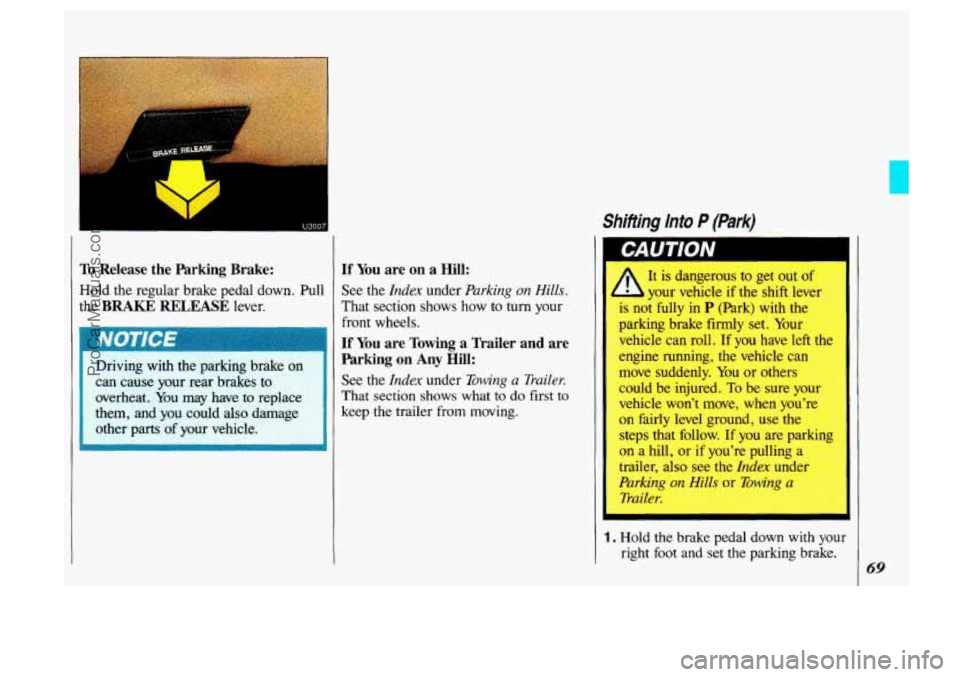
To Release the Parking Brake:
Hold the regular brake pedal down. Pull
the BRAKE RELEASE lever.
Driving with the parking brake
on
can cause your rear brakes to
overheat. You may have to replace
them, and you could also damage
i other parts of your vehicle. .. , m
If You are on a Hill:
See the Index under Parking on Hills.
That section shows how to turn your
front wheels.
If You are Towing a Trailer and are
Parking on Any Hill:
See the Index under Towing a Trailer.
That section shows what to do first to
keep the trailer
from moving.
Shiithg Into P (Park)
1
A
It is dangerous to get out 01
your vehicle if the shift lever
is not fully in
P (Park) with the
parking brake
firmly set. Your
vehicle can roll. If you have left
engine running, the vehicle can
move suddenly. You or others
could be injured.
To be sure your
vehicle won't move, when you're
on fairly level ground, use the
steps that follow.
If you are parking
on a hill,
or if you're pulling a
trailer, also see the Index under
Parking on Hills or Towing a
Trailer.
I
1. Hold the brake pedal down with your
right
foot and set the parhng brake.
69
ProCarManuals.com
Page 72 of 323
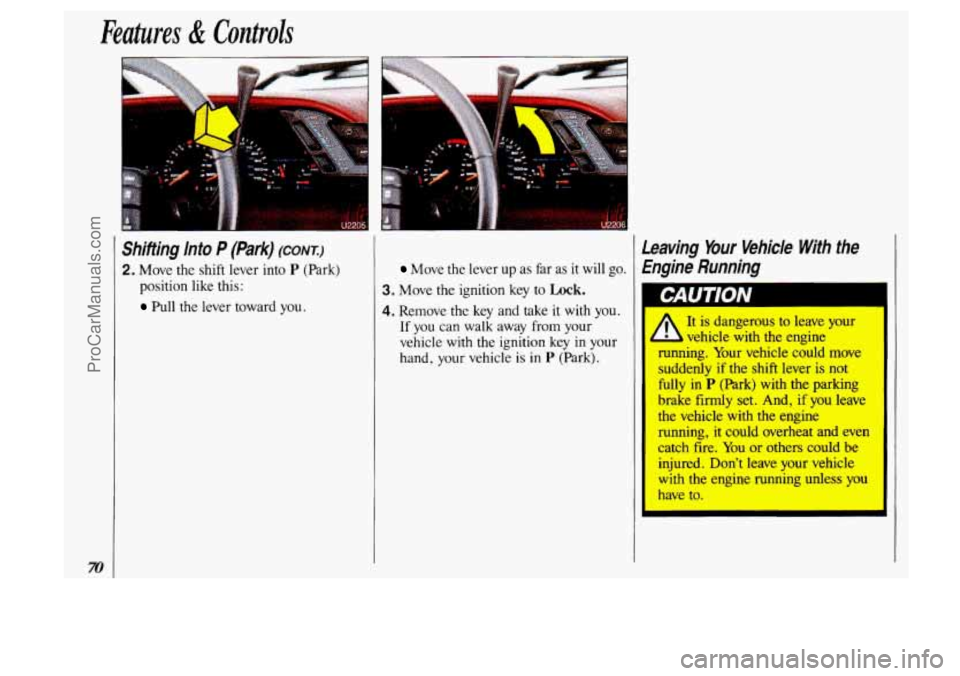
Features & Controls
I
Shifting Info P (Park) (CONI)
2. Move the shift lever into P (Park)
position like this:
Pull the lever toward you.
Leaving Your Vehicle With the
Move the lever up as far as it will go. Engine Running
3. Move the ignition key to Lock.
4. Remove the key and take it with you. I
If you can walk away from your
vehicle with the ignition key in yc
hand, your vehicle
is in P (Park).
1 CAUTION
ProCarManuals.com
Page 73 of 323
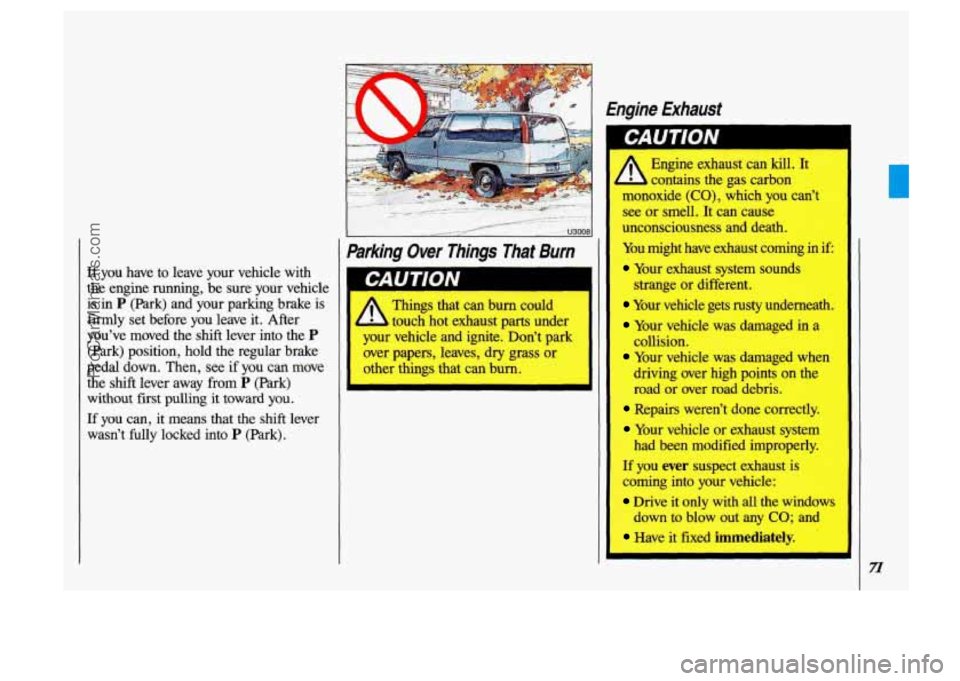
Engine Exhaust
If you have to leave your vehicle with
the engine
running, be sure your vehicle
is
in P (Park) and your parking brake is
firmly set before you leave it. After
you've moved the
shift lever into the P
(Park) position, hold the regular brake
pedal down. Then, see
if you can move
the shift lever away from
P (Park)
without first pulling
it toward you.
If you can, it means that the shift lever
wasn't fully locked into
P (Park).
I /.<*-- -+--,sa
Parking Over Things That Burn
Things that can burn could
touch hot exhaust
parts under I
A
Engine exhaust can kill. It
contains the gas carbon
monoxide
(CO), which you can't
see or smell. It can cause
unconsciousness and death.
You might have exhaust coming
in if
Your exhaust system sounds
strange or different.
1 I Your vehicle gets rusty underneath.
, Your vehicle was damaged in a
your vehicle and ignite: Don't park collision.
over
papers, leaves, dry grass or Your vehicle was damaged when
other things that can burn. driving over high points on the
Repairs weren't done correctly.
Your vehicle or exhaust system
had been modified improperly.
road
or over road debris.
If
you ever suspect exhaust is
coming into your vehicle:
Drive it only with all the windows
down to blow out any CO; and
Have it fixed immediately.
n
ProCarManuals.com
Page 74 of 323
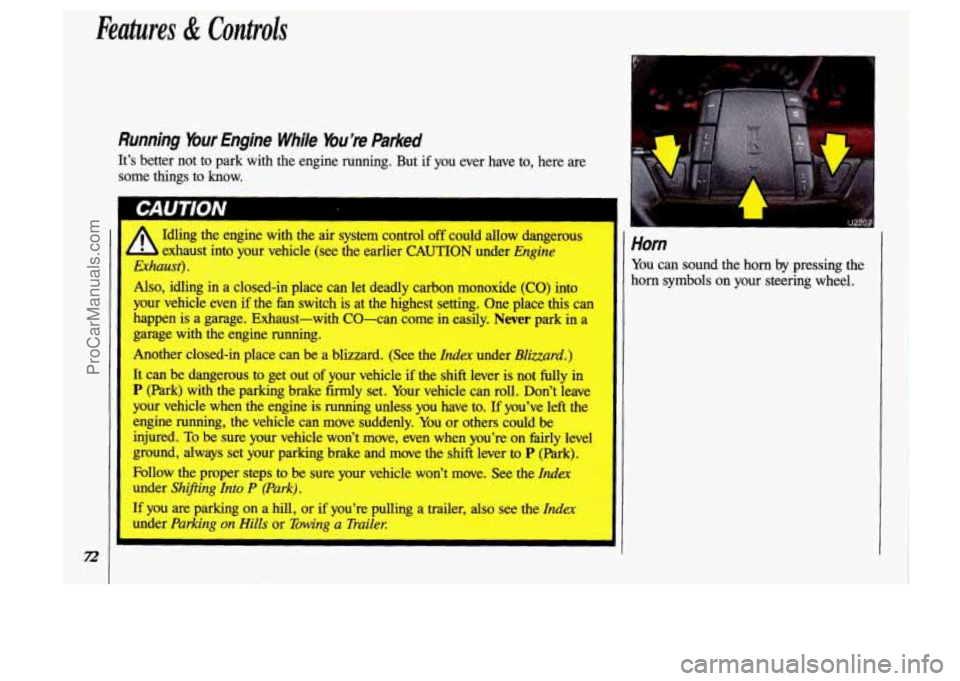
Features & Controls
n
Running bur Engine While You’re Parked
It’s better not to park with the engine running. But if you ever have to, here are
some things to know.
LAU I IUlV
A
Idling the engine with the air system control off could allow dangerous
exhaust into your vehicle (see the earlier CAUTION under
Engine
Exhaust).
Also, idling in a closed-in place can let deadly carbon monoxide (CO) into
your vehicle even if the fan switch
is at the highest setting. One place this can
happen is a garage. Exhaust-with CO-can come in easily.
Never park in a
garage with the engine running.
Another closed-in place can be a blizzard. (See the
Index under Blizzard.)
It can be dangerous to get out of your vehicle if the shift lever is not fully in
P (Park) with the parking brake firmly set. Your vehicle can roll. Don’t leave
your vehicle when the engine is running unless you have to.
If you’ve left the
engine running, the vehicle can move suddenly. You or others could be
injured.
To be sure your vehicle won’t move, even when you’re on fairly level
ground, always set your parking brake and move the shift lever to
P (Park).
Follow the proper steps to be sure your vehicle won’t move. See the
Index
under Shifing Into P (Park).
If you are parking on a hill, or if you’re pulling a trailer, also see the Index
under Parking on Hills or Towing a Trailer.
Horn
You can sound the horn by pressing the
horn symbols on your steering wheel.
ProCarManuals.com
Page 77 of 323
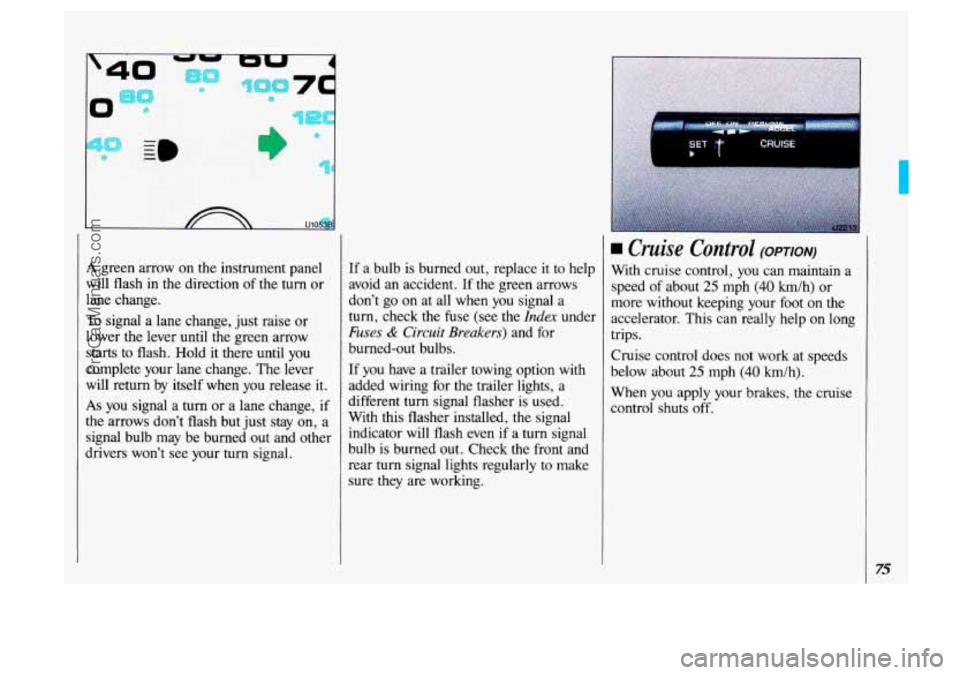
I
I&
A green arrow on. the instrument panel
will flash in the direction of the turn or
lane change.
To signal a lane change, just raise or
lower
the lever until the green arrow
starts to flash. Hold it there until you
complete your lane change. The lever
will return by itself when
you release it.
As you signal a turn or a lane change, if
the arrows don’t flash but just stay on, a
signal bulb may be burned out and other
dhvers won’t see your turn signal. If
a bulb is burned out, replace
it to help
avoid an accident. If the green arrows
don’t go on at all when you signal a
turn, check the fuse (see the
Index under
Fuses & Circuit Breakers) and for
burned-out bulbs.
If you have a trailer- towing option with
added wiring for the trailer lights, a
different
turn signal flasher is used.
With this flasher installed, the signal
indicator will flash even if a turn signal
bulb is burned out. Check
the front and
rear turn signal lights regularly to make
sure they are working.
SET T CRUISE b I
Cruise Control (OPTION)
With cruise control, you can maintain a
speed
of about 25 mph (40 km/h) or
more without keeping your foot
on the
accelerator. This can really help
on long
trips.
Cruise control does not work at speeds
below about
25 mph (40 km/h).
When you apply your brakes, the cruise
control shuts off.
75
ProCarManuals.com
Page 82 of 323
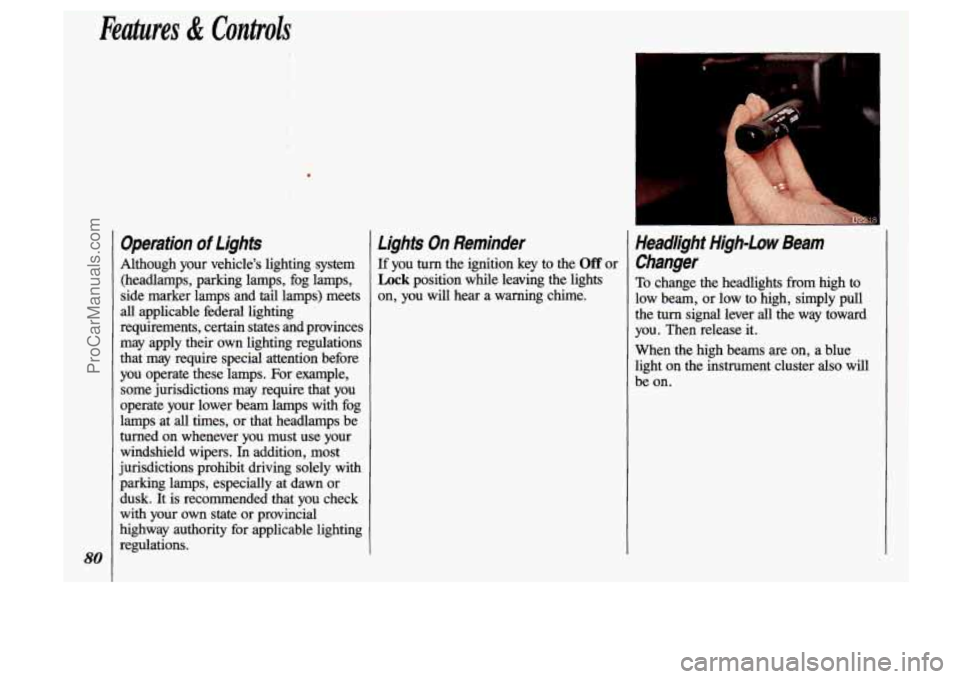
Features & Controls
80
Operation of Lights
Although your vehicle’s lighting system (headlamps, parking lamps, fog lamps,
side marker lamps and tail lamps) meets
all applicable federal lighting
requirements, certain states ahd provinces
may apply their own lighting regulations
that may require special attention before
you operate these lamps. For example,
some jurisdictions may require that you
operate your lower beam lamps with fog
lamps at all times, or that headlamps be
turned on whenever you must use your
windshield wipers. In addition, most
jurisdictions prohibit driving solely with parking lamps, especially at dawn or
dusk. It is recommended that you check
with your own state or provincial
highway authority for applicable lighting
regulations.
Lights On Reminder
If you turn the ignition key to the Off or
Lock position while leaving the lights
on, you will hear a warning chime.
I
Headlight High-Low Beam
Changer
To change the headlights from high to
low beam, or low to high, simply pull
the turn signal lever all the way toward
you. Then release it.
When the high beams are on, a blue
light on the instrument cluster also will
be on.
ProCarManuals.com
Page 94 of 323
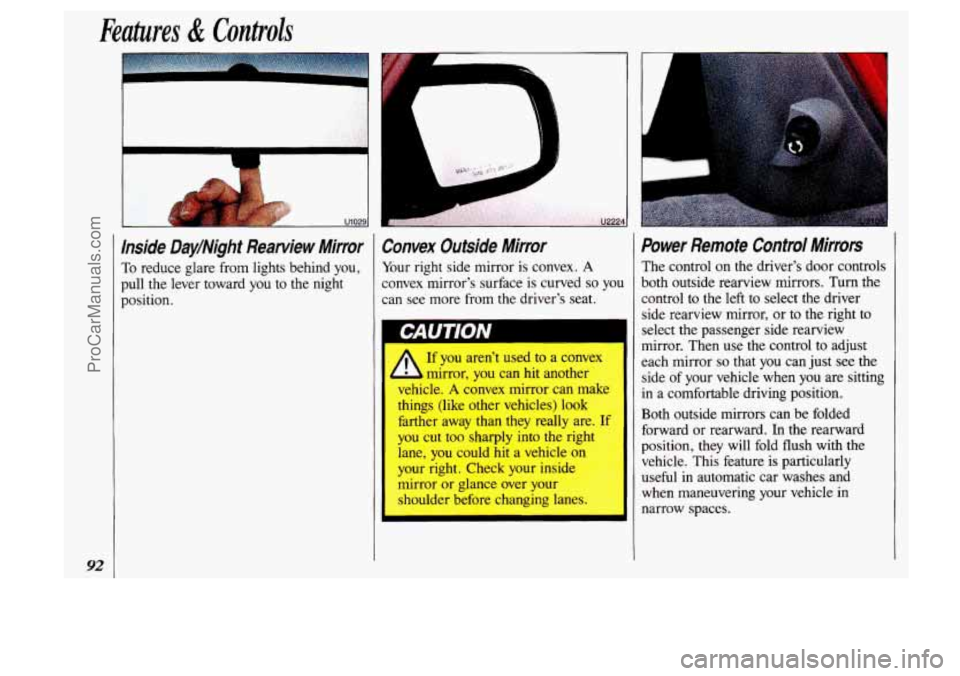
Features & Controls
92
I
Inside Day/Night Rearview Mirror
To reduce glare from lights behind you,
pull the lever toward
you to the night
position.
Convex Outside Mirror
Your right side mirror is convex. A
convex mirror's surface is curved so you
can see more from the driver's seat.
CAUTION
A
If you aren't used to a convex
mirror, you can hit another
vehicle.
A convex mirror can makL
things (like other vehicles)
look
farther away than they really are- If
you cut too sharply into the rig1
lane, you could
hit a vehicle on
your right. Check your inside
mirror or glance over your
shoulder before changing lanes
Power Remote Control Mirrors
The control on the driver's door controls
both outside rearview mirrors. Turn the
control to the left to select the driver
side rearview mirror, or to the right
to
select the passenger side rearview
mirror. Then use the control
to adjust
each mirror
so that you can just see the
side of your vehicle when
you are sitting
in a comfortable driving position.
Both outside mirrors can be folded
forward or rearward.
In the rearward
position, they will fold flush with the
vehicle. This feature is particularly
useful in automatic car washes and
when maneuvering your vehicle in
narrow spaces.
ProCarManuals.com
Page 110 of 323
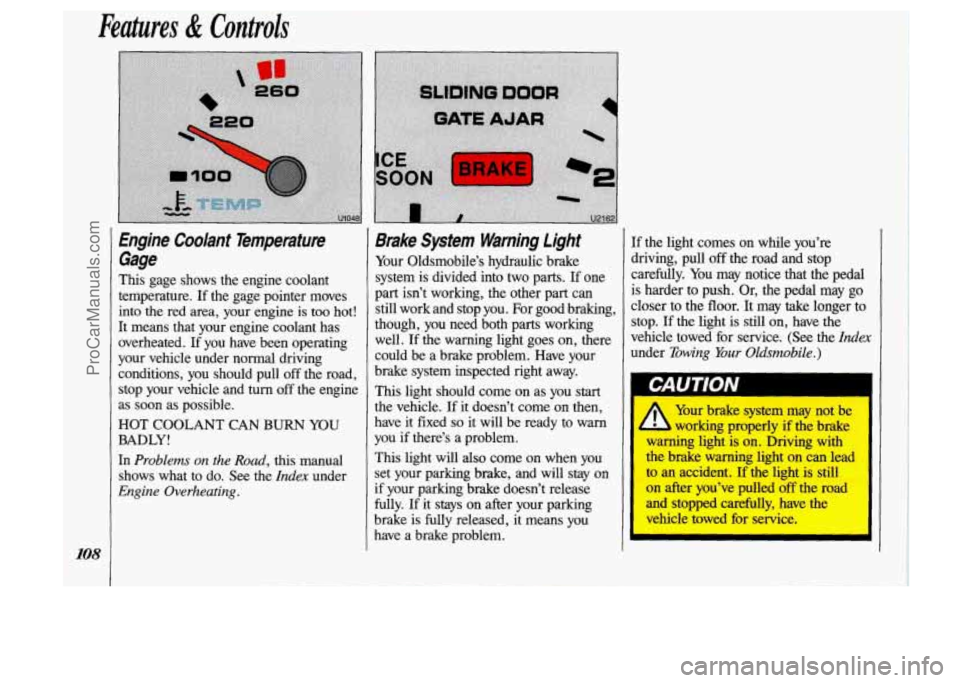
I
Features & Controls
Engine Coolant Temperature Gage
This gage shows the engine coolant
temperature. If the gage pointer moves
into the red area, your engine is too hot!
It means that your engine coolant has overheated.
If you have been operating
your vehicle under normal driving conditions, you should pull off the road,
stop your vehicle and
turn off the engine
as soon as possible.
HOT COOLANT CAN BURN YOU
BADLY!
In Problems on the Road, this manual
shows what to do. See the
Index under
Engine Overheating.
Brake System Warning Light
Your Oldsmobile’s hydraulic brake
system is divided into two parts. If one
part isn’t working, the other part can
still work and stop you. For good braking,
though, you need both parts working
well.
If the warning light goes on, there
could be a brake problem. Have your
brake system inspected right away.
This light should come on as you start
the vehicle.
If it doesn’t come on then,
have it fixed
so it will be ready to warn
you if there’s a problem.
This light will
also come on when you
set your parking brake, and will stay on
if your parking brake doesn’t release
fully.
If it stays on after your parking
brake is fully released, it means you have a brake problem.
I
If the light comes on while you’re
driving, pull off the road and stop
carefully. You may notice that the pedal
is harder to push. Or, the pedal may go
closer to the floor. It may take longer to
stop.
If the light is still on, have the
vehicle towed for service.
(See the Index
under Towing Your Oldsrnobile.)
Your brake system may not be
h working properly if the brake
-kg light is on. Driving with
cllu ,,&e warning light on can lead
to
an accident. If the light is still
on after you’ve pulled off the road
and stopped carefully, have the
vehicle towed for service.
ProCarManuals.com
Page 117 of 323
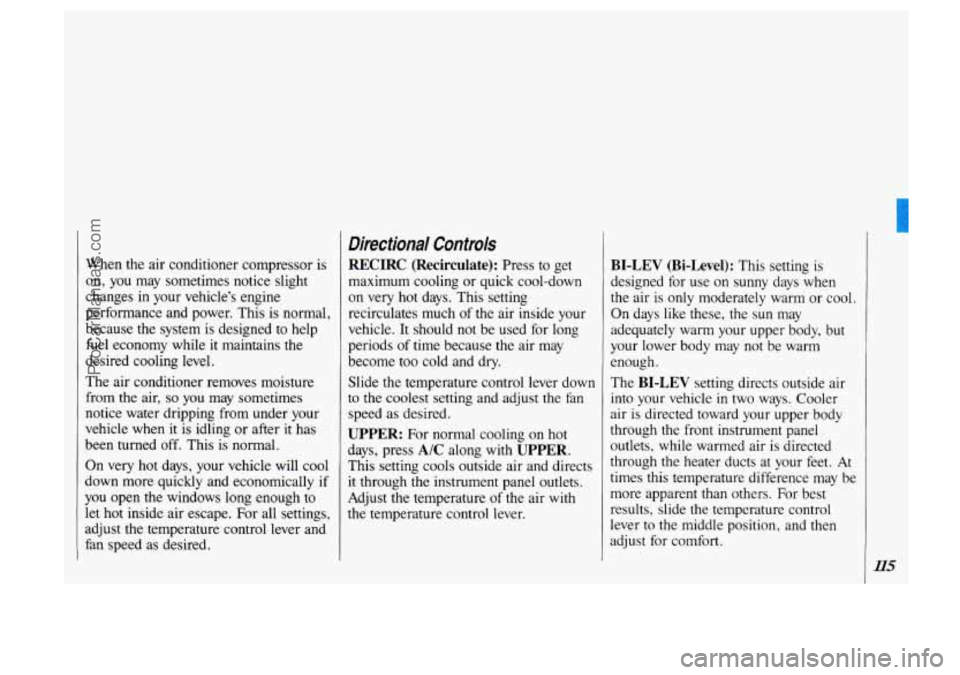
When the air conditioner compressor is
on, you may sometimes notice slight
changes in your vehicle’s engine
performance and power. This is normal,
because the system is designed to help
fuel economy while it maintains the
desired cooling level.
The air conditioner removes moisture
from the air,
so you may sometimes
notice water dripping from under your
vehicle when it is idling or after it has
been turned off. This is normal.
On very hot days, your vehicle will cool
down more quickly and economically if
you open the windows long enough to
let hot inside air escape. For all settings,
adjust the temperature control lever and
fan speed as desired.
Directional Controls
RECIRC (Recirculate): Press to get
maximum cooling or quick cool-down
on very hot days. This setting
recirculates much of the air inside your
vehicle.
It should not be used for long
periods
of time because the air may
become too cold and dry.
Slide the temperature control lever down
to the coolest setting and adjust the fan
speed as desired.
UPPER: For normal cooling on hot
days, press
A/C along with UPPER.
This setting cools outside air and directs
it through the instrument panel outlets.
Adjust the temperature of the air with
the temperature control lever.
BI-LEV (Bi-Level): This setting is
designed for use
on sunny days when
the air is only moderately warm or cool.
On days like these, the sun may
adequately warm your upper body, but
your lower body may not be warm
enough.
The
BI-LEV setting directs outside air
into your vehicle
in two ways. Cooler
air is directed toward your upper body
through the front instrument panel
outlets, while warmed air
is directed
through the heater ducts at your feet.
At
times this temperature difference may be
more apparent than others. For best
results, slide
the temperature control
lever to the middle position, and then
adjust for comfort.
ProCarManuals.com
Page 121 of 323
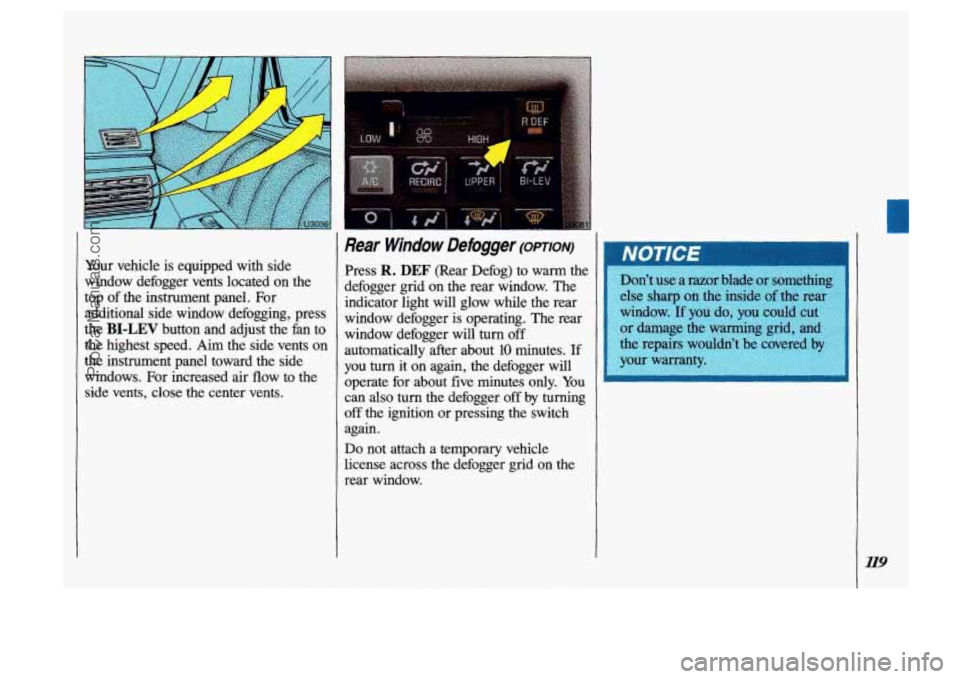
Your vehicle is equipped with side
window defogger vents located on the
top of the instrument panel. For
additional side window defogging, press
the
BI-LEV button and adjust the fan to
the highest speed.
Aim the side vents on
the instrument panel toward the side
windows. For increased air flow to the
side vents, close the center vents.
Rear Window Defogger (omoiv)
Press R. DEF (Rear Defog) to warm the
defogger grid on the rear window. The
indicator light will glow while the rear window defogger is operating. The rear
window defogger will turn
off
automatically after about 10 minutes. If
you turn it on again, the defogger will
operate for about five minutes only. You
can
also turn the defogger off by turning
off the ignition or pressing the switch
again.
Do not attach a temporary vehicle
license across the defogger grid on the
rear window.
119
ProCarManuals.com